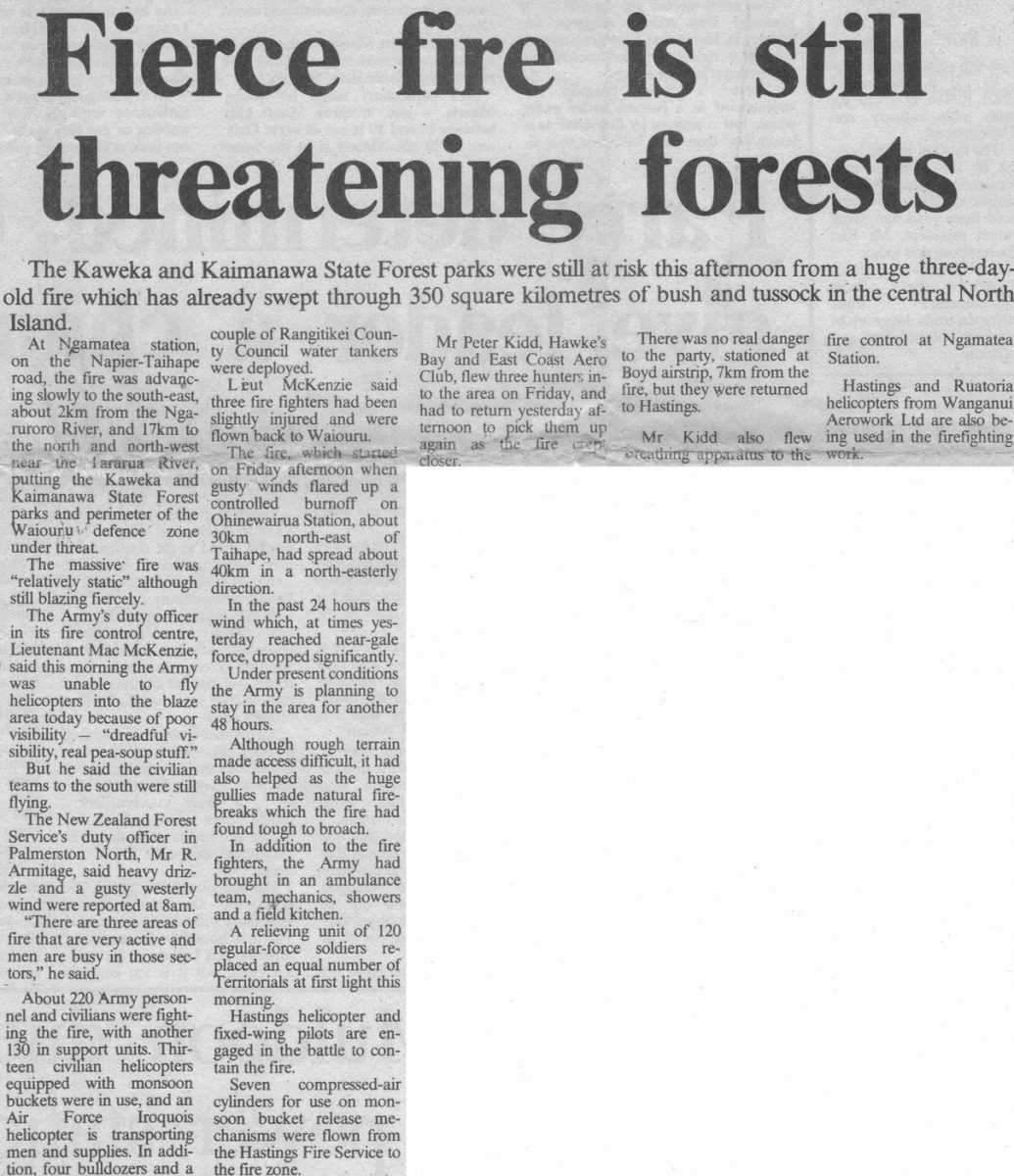Fierce fire is still threatening forests
The Kaweka and Kaimanawa State Forest parks were still at risk this afternoon from a huge three-day-old fire which has already swept through 350 square kilometres of bush and tussock in the central North Island.
At Ngamatea Station, on the Napier-Taihape road, the fire was advancing slowly to the south-east, about 2km from the Ngaruroro River, and 17km to the north and north-west near the Tararua River, putting the Kaweka and Kaimanawa State Forest parks and perimeter of the Waiouru defence zone under threat.
The massive’ fire was “relatively static” although still blazing fiercely.
The Army’s duty officer in its fire control centre, Lieutenant Mac McKenzie, said this morning the Army was unable to fly helicopters into the blaze area today because of poor visibility – “dreadful visibility, real pea-soup stuff.”
But he said the civilian teams to the south were still flying.
The New Zealand Forest Service’s duty officer in Palmerston North, Mr R. Armitage, said heavy drizzle and a gusty westerly wind were reported at 8am.
“There are three areas of fire that are very active and men are busy in those sectors,” he said.
About 220 Army personnel and civilians were fighting the fire, with another 130 in support units. Thirteen civilian helicopters equipped with monsoon buckets were in use, and an Air Force Iroquois helicopter is transporting men and supplies. In addition, four bulldozers and a couple of Rangitikei County Council water tankers were deployed.
Lieut McKenzie said three fire fighters had been slightly injured and were flown back to Waiouru.
The fire, which-started on Friday afternoon when gusty winds flared up a controlled burnoff on Ohinewairua Station, about 30km north-east of Taihape, had spread about 40km in a north-easterly direction.
In the past 24 hours the wind which, at times yesterday reached near-gale force, dropped significantly.
Under present conditions the Army is planning to stay in the area for another 48 hours.
Although rough terrain made access difficult, it had also helped as the huge gullies made natural firebreaks which the fire had found tough to broach.
In addition to the fire fighters, the Army had brought in an ambulance team, mechanics, showers and a field kitchen.
A relieving unit of 120 regular-force soldiers replaced an equal number of Territorials at first light this morning.
Hastings helicopter and fixed-wing pilots are engaged in the battle to contain the fire.
Seven compressed-air cylinders for use on monsoon bucket release mechanisms were flown from the Hastings Fire Service to the fire zone.
Mr Peter Kidd, Hawke’s Bay and East Coast Aero Club, flew three hunters into the area on Friday, and had to return yesterday afternoon to pick them up again as the fire came closer.
There was no real danger to the party, stationed at Boyd airstrip, 7km from the fire, but they were returned to Hastings.
Mr Kidd also flew breathing apparatus to the fire control at Ngamatea Station.
Hastings and Ruatoria helicopters from Wanganui Aerowork Ltd are also being used in the firefighting work.












Do you know something about this record?
Please note we cannot verify the accuracy of any information posted by the community.